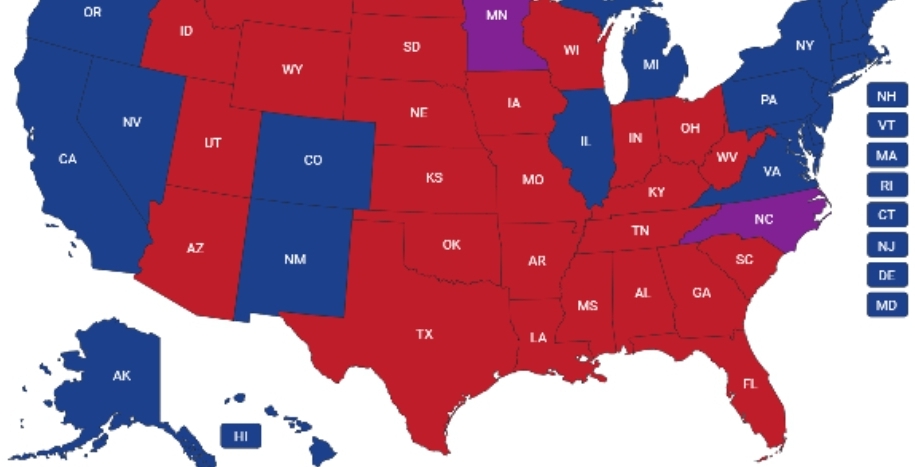With the 2024 United States presidential election in full swing, there is no question that this election will be very close. Polls are indicating a very tight race between incumbent President Biden on the Democratic side and former President Trump on the Republican side. It is the election that most people in the world care about other than the elections in their own country. Of course, one thing that needs to be highlighted is America’s unique way of choosing its commander-in-chief – it remains the only presidential republic to not elect its president using the popular vote method. Today, we’re going to explore the ins and outs of the Electoral College and whether it should continue to exist in America today.
The map of states and their current electoral votes.
What is the Electoral College?
Article II, Section I, Clause II of the Constitution directs each state to appoint a certain number of electors, equal to the number of members in a state’s congressional delegation (the number of members of the House of Representatives plus two senators). The number of members of the House of Representatives from a state is decided by the state’s population, so larger states get more electors. For instance, California, the most populous state, gets fifty-four electors as opposed to New Jersey, which gets fourteen.
The Electoral College was initially added to the Constitution back in the 1780s after pressure from slave states that wanted to increase their voting power (since they counted slaves as three-fifths of a person and as a result would get more electors) and from smaller states that were able to increase their voting power due to having a minimum of three electors per state.
Today, there are 538 electors, divided among the fifty states and the District of Columbia. A presidential candidate must win at least 270 to win the presidency. While initially, state legislatures chose how the electors would vote, today all 50 states use the popular vote method to determine how their electors would vote. In other words, the state’s electoral votes are awarded to whichever presidential candidate wins the popular vote in the state. Besides these facts, the system has gone relatively unchanged since 1789, with hundreds of reform attempts ending up unsuccessful in Congress.
48 states and DC use a winner-take-all system, where the winner of the state gets all of the electoral votes. Maine and Nebraska award one electoral vote to the popular vote winner in each of their congressional districts and their remaining two electoral votes to the statewide winner, which often leads to a split of electoral votes between the candidates.
Would-be electors are chosen by the political parties, with the state’s popular vote determining which party’s slate would become electors. Members of the Electoral College would then meet and vote in their respective states on the Monday after the second Wednesday in December after Election Day, with a joint session of Congress ratifying the electoral votes on January 6, paving the way for the new President to be sworn in on January 20.
What If No One Wins a Majority?
Considering the closeness of this year’s election, there is a small possibility that the Electoral College might end up in a 269-269 tie between the two candidates, meaning no one wins a majority In that case, the House of Representatives steps in and selects the new President, with each state’s delegation getting one vote each. If the Electoral College does go in this direction, such a step would benefit Trump, as Republicans currently control 26 state delegations – a majority of contingency votes needed to win.
The current control of congressional delegations as of 2024.
Faithless Electors
Electors often vote for the candidate they are pledged to vote for, but may not always do that. In the 2016 election, seven electors chose not to vote for the candidate they were assigned to vote for and voted for a different candidate instead. These so-called “faithless electors” often face censure from their parties if they do such an act, and as a result, many states have passed laws to ban or fine these faithless electors. In response, faithless electors argued in a case before the Supreme Court that being fined for not voting the way they pledged to vote was a violation of their constitutional rights – an argument the Court rejected in Chiacalo v. Washington (2020). Due to the widespread dislike for both Trump and Biden, it would not be surprising if electors attempted not to vote the way they pledged to do so.
The Strengths and Flaws of the Electoral College
Some of you reading this may have come to the conclusion that the Electoral College seems very undemocratic. This is the main argument many critics have brought forth, citing the fact that since smaller states are overrepresented in the electoral college, it may cause the runner-up in the popular vote to win, as was the case in 1824, 1876, 1888, 2000, and 2016. Critics have also objected to the fact that as a result of the Electoral College, candidates tend to focus their sights on swing states with large electoral vote totals, often ignoring the rest of the states and making voters in those states feel like their votes do not matter. There is also criticism of the fact that most states use the “winner-take-all” method in awarding electoral votes which is not aligned with the principle of proportional representation (e.g. a candidate wins 51% of the vote in a state and gets 100% of the electoral votes). Indeed, majorities of Americans have consistently agreed with doing away with the Electoral College altogether, with a 2023 poll saying 65% of Americans support abolition. On the other hand, supporters of the Electoral College have said that the institution requires presidential candidates to have broad appeal across the country to win and that it keeps small states relevant in national politics. Republicans have also come out strongly against abolishing the Electoral College, given the fact that they have lost the popular vote in seven of the last eight elections and produced two Republican Presidents (George W. Bush in 2000 and Donald Trump in 2016) who did not win the nationwide popular vote but won the Electoral College and the presidency.
The National Popular Vote Interstate Compact
In order to reform the Electoral College and make it more democratic, many have given their support to the National Popular Vote Interstate Compact (NPV). Under it, states would pledge to give their electors to the candidate who won the nationwide popular vote. This in theory retains the Electoral College but renders it useless. Supporters say it would incentivize presidential candidates to expand their campaigns nationwide instead of focusing on a few states. However, the compact has yet to come into effect, as it would only take effect if states with a total of 270 electoral votes ratified it. As of 2024, seventeen states and DC totaling 209 electoral votes have ratified the compact.
My Take
In a country that so often boasts itself as a bastion of democracy, it is ironic that it relies on an undemocratic institution to elect its leader. The fact that it may often pick a person that a majority of people did not even want is the main factor that should discount its purpose. Its racist origins (the Electoral College had been advocated for by slave states in order to gain more voting power) further prove why it is irrelevant in today’s world. Abolishing the Electoral College would not only make things more democratic but would force candidates to not just appeal to select constituent groups in a few select states but also to the rest of the country. Candidates should be able to appeal to the entire electorate. In my opinion, this would boost voter turnout and convince voters that presidential candidates are actually fighting for their votes. In a world where every other democracy uses the will of the people to elect their leader, the world’s leading democracy just so happens to use an archaic and unrepresentative system to pick theirs. The Electoral College must go if the United States seeks to become the role model of democracy it often claims itself to be.
Sources:
- https://www.archives.gov/electoral-college/about
- https://constitution.congress.gov/browse/article-2/
- https://www.270towin.com/2016_Election
- https://history.house.gov/Institution/Election-Statistics/Election-Statistics/
- https://www.supremecourt.gov/opinions/19pdf/19-465_i425.pdf
- https://www.nationalpopularvote.com/written-explanation
Emil Ordonez, a rising college freshman, is the founder and editor-in-chief of Polinsights. He has been deeply passionate about politics and history since learning every U.S. President at the age of five. He was compelled to start this blog after meeting many people who were misinformed or had become apathetic about how society worked. He hopes to provide factual knowledge and insights that will encourage people, especially the young, to get more engaged in their respective communities. In his free time, he edits for Wikipedia and makes maps for elections. He aspires to work in Congress or even the White House in the future.


Leave a Reply